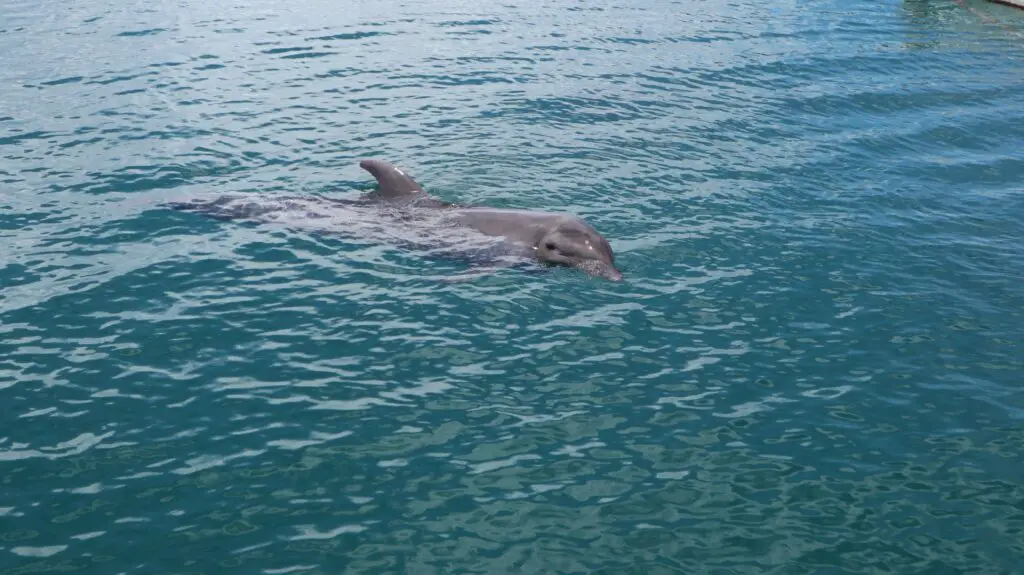
Dolphins are highly intelligent marine mammals that belong to the family of Delphinidae. They are known for their playful behavior, social nature, and remarkable communication abilities. Dolphins have fascinated humans for centuries and continue to be a subject of scientific study, conservation efforts, and admiration for their intelligence and beauty.
Here are some fun facts about the marine mammals:
Species and Diversity
There are around 40 recognized species of dolphins, ranging in size from 4 to 30 feet (1.2 to 9 meters) in length. They are found in oceans and seas worldwide, inhabiting both saltwater and freshwater environments.
Physical Characteristics
Dolphins have streamlined bodies with a dorsal fin on their back and a long snout called a rostrum. They have excellent eyesight both in and out of the water. Dolphins breathe air through a blowhole located on the top of their heads.
Social Behavior
Dolphins are highly social animals and often live in groups called pods, which can range in size from a few individuals to hundreds. They exhibit complex social structures and communicate with each other using a variety of clicks, whistles, and body movements.
Intelligence and Problem-Solving Abilities
Dolphins are regarded as one of the most intelligent animals on Earth. They display self-awareness, can recognize themselves in mirrors, and exhibit problem-solving skills. They have been observed using tools, coordinating hunting strategies, and even showing signs of empathy.
Echolocation
Dolphins use echolocation to navigate and find food. They emit clicking sounds and interpret the echoes that bounce back, allowing them to create mental maps of their surroundings and locate prey.
Feeding Habits
Dolphins are carnivorous and feed on a diet primarily consisting of fish and squid. They are skilled hunters and often work together in groups to corral and capture their prey.
Reproduction and Lifespan
Female dolphins typically give birth to a single calf after a gestation period of 9 to 17 months, depending on the species. The calf is nursed by the mother and stays with her for a period ranging from a few months to a few years. Dolphins have relatively long lifespans, with some species living up to 50 years or more.
Threats and Conservation
Like any other animals, dolphins face various threats, including entanglement in fishing gear, habitat degradation, pollution, and hunting in some regions. Conservation efforts aim to protect dolphins and their habitats, promote responsible fishing practices, and reduce pollution to ensure their long-term survival.
Dolphins have been known to interact positively with humans in various settings. They can be trained to perform in shows and exhibitions, and they have been a popular attraction at marine parks and aquariums around the world. Let me share one of the videos that I saved from the show that we recently watched.
Our family was able to watch the dolphins’ performance as it is one of the itinerary of my daughter’s school educational field trip. Seeing the dolphins was one of the things she had been looking forward to since the day she learned about the field trip.
As we arrived at the place, we were also one of the lucky few who saw one of the dolphins welcoming us and the other audience before the performance.
Everyone was so happy and entertained by these mammals but most especially my kid. It was my daughter’s first time seeing and watching the Dolphin Show and she had so much fun watching every movement of those marine mammals. It was also our first time seeing her teary eyes due to great amount of happiness.


She wasn’t even bothered by the hot weather until it changed from hot to rainy. As my husband and I looked at her, all we saw was pure happiness. Happiness that she will surely remember.
Other than having so much fun, she also learned a lot of things about them as the host of the show educated everyone about these marine mammals. The show also reminded everyone about the danger that dolphins could get into when people throw garbage in the sea.
Garbage may contain harmful substances, such as chemicals or pollutants, that can contaminate the water and subsequently affect dolphins. Dolphins may accidentally ingest or become entangled in discarded materials, leading to injury, illness, or even death.
Training the Dolphins
When dolphins perform in shows, they are usually trained through positive reinforcement techniques. This involves rewarding the dolphins with treats, praise, or play sessions when they successfully perform specific behaviors or tricks. Dolphins are highly intelligent and trainable, and they can quickly learn and execute a variety of tasks.
It’s worth noting that the captivity and training of dolphins for entertainment purposes have been a subject of ethical debate. Concerns have been raised regarding the welfare and natural behavior of dolphins in captive environments, as well as the methods used for training and the impact on their physical and mental well-being.
Ultimately, it’s important for individuals and organizations to prioritize the well-being and conservation of dolphins, and to ensure that any interactions or performances are conducted in a manner that respects their natural behaviors and habitats.
To protect dolphins and their habitats, it is crucial to prevent the disposal of garbage and pollutants into their natural environments. Promoting responsible waste management practices, reducing plastic consumption, recycling, and raising awareness about the impact of pollution on marine life are essential steps toward safeguarding the well-being of dolphins and preserving their habitats.

Leave a Reply